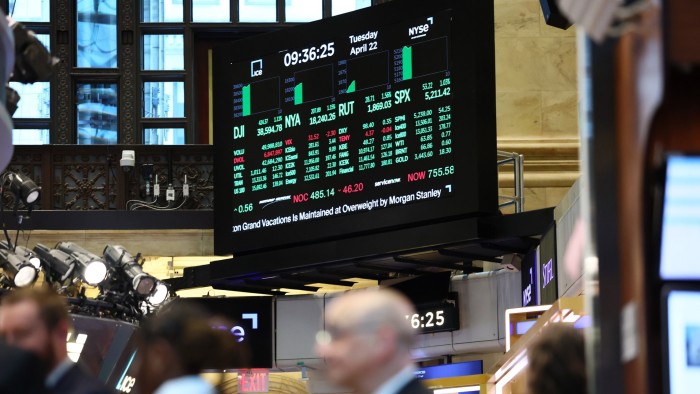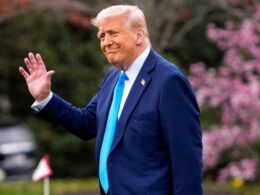Welcome back. Every twist and turn from the White House brings a new rally or sell-off in the S&P 500. But is the market missing the bigger picture?
Despite signs of a slowing US economy, Donald Trump’s tariff plans and stultifying uncertainty, Wall Street analysts still expect the main US stock index to end 2025 just below 6,000 on average. That means the market projects the S&P 500 will rise by at least 5 per cent between now and December 31.
So this week, I’ll outline the case for why the market is wrong, and why the S&P 500 is more likely to end this year significantly below its current level of 5,525.
End-year stock market forecasts are ultimately underpinned by investors’ annual economic outlook and their assessment of structural drivers, such as artificial intelligence and US exceptionalism.
For 2025, analysts essentially expect the S&P 500 level to be broadly unchanged on last year. That is a notable markdown from the past two years of consecutive annual growth above 20 per cent. But is it still too optimistic?
Let’s begin with the economic fundamentals. Last month, I argued that America was heading for a recession. (This was based on economic weakness coming into Trump’s second term, the uncertainty of his policies, and the possibility of some import duties being implemented.) I appreciate that this isn’t Wall Street’s view, yet.
Analysts are more focused on actual tariff announcements. Indeed, since “liberation day”, consensus growth forecasts for 2025 have fallen and probabilities for a recession in the next 12 months have risen to 45 per cent. Most expect the US effective tariff rate (pre-substitution effects) to settle around 10 to 20 per cent this year. It is currently estimated at around 28 per cent, having started 2025 close to 2.5 per cent.
These forecasts seem reasonable: notably higher tariffs than last year and slower growth, even if there is no recession. However, the market is still pricing more optimistically than that.
“The information derived from risk assets doesn’t even suggest markets reckon a mild slowdown will take shape this year,” said Daniel Von Ahlen, a senior macro strategist at TS Lombard, utilising a simple regression model to estimate US growth forecasts from asset prices.
Expectations for corporate earnings this year remain too high. It is easier for Wall Street to make buy and sell decisions based on perceived risk-on or risk-off news items. Judging their impact on companies’ bottom lines can take longer.
“Typically earnings estimates decline during even mild recessions,” said Peter Berezin, chief global strategist at BCA Research. “But the market currently assumes nearer 10 per cent earnings growth over the next 12 months. That’s off last year’s peak profit margins no less.”
Analysts may be too optimistic about the ability of companies to pass through any tariff costs to consumers. The sectors that import the most — industrials, materials and consumer discretionary — also have limited pricing power, notes BCA Research’s US equity strategy team.
Assuming companies won’t be able to raise prices significantly, it shows Trump’s tariffs reducing S&P 500 net income margins by 2.2 percentage points. That would translate to a 19.2 per cent decline in S&P 500 earnings per share, all else equal (based on tariff rates at 10 per cent for all countries, Chinese import duties returning to their pre-retaliation rate of 54 per cent, and steel, aluminium and car-specific levies at 25 per cent.)
For measure, Goldman Sachs estimates that each 5 percentage point rise in the US tariff rate leads S&P 500 EPS to fall roughly between 1 to 2 per cent.
Whatever one’s tariff outlook, consensus forecasts for EPS to grow notably in 2025 appear at odds with the current economic environment: high uncertainty, weak consumer and investor confidence, and elevated import duties. (Scheduled vessels into the Port of Los Angeles are expected to drop significantly year on year in two weeks’ time.)
Earnings revisions are coming in rapidly now. The number of earnings downgrades by analysts for 2025 is ironically at recessionary levels, though the actual magnitudes of the downgrades remain relatively less significant. As earnings projections come down, prices will follow, as analysts calibrate valuations.
For measure, the forward price-to-earnings ratio (how much investors are willing to pay for each dollar of future earnings) is currently around 19. In the five years prior to the pandemic, it was closer to 17. And in all recessions since 1980, it has averaged around 10.
Using Goldman Sachs’ S&P 500 sensitivity matrix, a still modest forecast for EPS to grow by 3 per cent this year and forward P/E ratios to return to just above their pre-pandemic average would put the index nearer to 4,550.
Of course, it is possible for the S&P 500 to dodge such a hefty fall if structural factors provide buying impetus.
But first, the AI narrative is hitting roadblocks. DeepSeek’s low-cost model release in China put the spotlight on the billions being spent by US tech firms on AI capital. Trump’s trade announcements — including planned duties on Asian tech manufacturing hubs and chip export restrictions — have added further pressure.
“We’re still waiting for a ‘killer app’ that justifies the heavy capex taking place. The low barriers to building large language models also raise further questions over the revenue [the Magnificent Seven] can generate”, explains Hugh Grieves, a fund manager at Premier Miton Investors. “[They] are also only slowly assessing how tariffs impact their earnings”.
The stock prices of the Magnificent Seven tech businesses have dropped substantively since Trump’s inauguration. But analysts are unclear on what is being priced in. The companies account for one-third of the S&P 500’s market capitalisation. (They also skew net profit margin estimates for the whole stock market upward.) So selling them is an easy way to cut risk exposure as the news whipsaws.
Still, their forward P/E multiples remain above pre-pandemic levels (individually and collectively). Prices could drop further as their profitability is re-evaluated, both in terms of tariffs and AI hype.
Second, US exceptionalism. For years America has attracted capital by virtue of its deep liquidity, stability and the safe-haven status of its assets. This enabled the S&P 500 to grow beyond economic fundamentals.
But the narrative is weakening. In March, respondents to Bank of America’s Fund Manager survey slashed their US equity holdings by the most on record. Tariffs weigh disproportionately on America. Its companies are the greatest beneficiaries of the “Made in Asia” model, notes Matt King, founder of Satori Insights. (Retaliatory measures will hurt US firms too.)
Policy upheaval, radical uncertainty, rising financial stability risks and attacks on independent economic institutions (such as the US Federal Reserve most recently) make the US a less reliable place to park capital.
“The US has gone from the ‘cleanest dirty shirt’ to being one of the ugliest and yet still most expensive item cluttering the investment wardrobe,” says King. “Even after this year’s correction, US equities retain a significant exceptionalism premium trading on forward P/Es 50 per cent higher than non-US equities.”
This exposes America to further capital flight, depending on the attractiveness of opportunities abroad and Trump’s actions. Paradoxically, if the president’s term continues as it has started, the US will be more reliant on improved economic fundamentals to build buying momentum.
The S&P 500 has oscillated down around 10 per cent from its February peak. But the newsflow makes it difficult to know what has and hasn’t been priced in.
The constant churn of policy announcements, exemptions, postponements and denials mean investors re-price each day where they consider risk to be relative to the day before. This then shifts the goalposts for judging growth and profitability forecasts.
For all the noise, however, the market still seems positioned for a hopeful outcome. Stocks are not even priced right now for a mild downturn. “For the S&P 500 to rise to where the consensus is now, Trump would need to immediately roll back tariffs”, reckons Berezin.
Sure, recent climbdowns suggest the president can be turned somewhat. But by how much? And when? If most investors reasonably expect tariff rates to eventually settle at least several multiples higher under Trump than where they started 2025, they are yet to fully price that in, along with the lingering impact of economic uncertainty.
Wall Street’s earnings and growth projections have further to fall. As they do, markets may also further scrutinise the AI and US exceptionalism narratives. That’s why I fear the S&P 500 will end the year not with a 5 handle, let alone a 6 — but with a 4.
Send your rebuttals, reflections and end-year S&P 500 forecasts to freelunch@ft.com or on X @tejparikh90.
Food for thought
Planning a social media detox? A new study of Facebook and Instagram deactivations before the 2020 US election found improvements in measures of users’ happiness, depression and anxiety.
Source link














